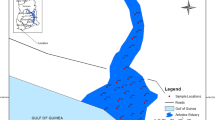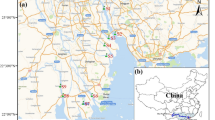Abstract
The existing methods of measuring combined toxicity of heavy metal mixtures in environment do not fully consider three major factors (i.e., number of heavy metal species, aquatic biota, all investigated sites as an entity). Herein, a new method named joint probabilistic risk (JPR) method is proposed for evaluating the combined toxicity of heavy metal mixtures to aquatic biota. In this new method, the above three factors are fully taken into account. In order to evaluate the feasibility of the new method, the Pearl River Estuary (PRE) is selected as a case study. Concentrations of heavy metals (Cd, Pb, Cr, Ni, Cu, and Zn) in surface sediments of PRE are investigated and toxic equivalent factors (TEFs) of these heavy metals are calculated. Based on TEFs, sedimental concentrations of heavy metals of PRE are converted to Cd toxic equivalent concentration (Cdeq), while the Cd toxicity data (Cdto) are extracted from the literature. The probability density curves for Cdeq and Cdto are constructed and the overlap area is quantified as 0.2497. This indicates that the surface sediments of PRE have a 24.97% probability of toxic effect towards aquatic biota. Finally, this new method is validated by two indirect methods of mERMq and mPELq.




Similar content being viewed by others
Data availability
The datasets generated during and/or analyzed during the current study are available from the corresponding author on reasonable request.
References
Acevedo-Figueroa D, Jiménez BD, Rodríguez-Sierra CJ (2006) Trace metals in sediments of two estuarine lagoons from Puerto Rico. Environ Pollut 141:336–342
Backhaus T, Faust M (2012) Predictive environmental risk assessment of chemical mixtures: a conceptual framework. Environ Sci Technol 46:2564–2573
Balistrieri LS, Mebane CA (2014) Predicting the toxicity of metal mixtures. Sci Total Environ 466-467:788–799
Bryan GW, Langston WJ (1992) Bioavailability, accumulation and effects of heavy metals in sediments with special reference to United Kingdom estuaries: a review. Environ Pollut 76:89–131
Carr SR, Chapman DC, Long ER, Windom HL, Thursby G, Sloane GM, Wolfe DA (1996) Sediment quality assessment studies of Tampa bay, Florida. Environ Toxicol Chem 15:1218–1231
CAS (Chinese Academy of Sciences) (2012) Chinese Academy of Sciences completes accurate measurement of Pearl River length and drainage area. http://www.cas.cn/ky/kyjz/201202/t20120215_3440662.shtml.
Chen X, Li HZ, You J (2015) Joint toxicity of sediment-associated permethrin and cadmium to Chironomus dilutus: The role of bioavailability and enzymatic activities. Environ Pollut 207:138–144
Ciarelli S, Vonck WAPMA, van Straalen NM (1997) Reproducibility of spiked-sediment bioassays using the marine benthic amphipod, Corophium volutator. Marine Environ Res 43:329–343
CSBTS (China State Bureau of Quality and Technical Supervision) (2002) Marine Sediment Quality (GB 18668-2002). Standards Press of China, Beijing
Di Toro DM, Mahony JD, Hansen DJ, Scott KJ, Hicks MB, Mayr SM, Redmond MS (1990) Toxicity of cadmium in sediments: The role of acid volatile sulfide. Environ Toxicol Chem 9:1487–1502
Duodu GO, Goonetilleke A, Ayoko GA (2016) Comparison of pollution indices for the assessment of heavy metal in Brisbane River sediment. Environ Pollut 219:1077–1091
Eggleton J, Thomas KV (2004) A review of factors affecting the release and bioavailability of contaminants during sediment disturbance events. Environ Int 30:973–980
Fu FL, Wang Q (2011) Removal of heavy metal ions from wastewaters: a review. J Environ Manag 92:407–418
Gan HY, Liang K, Zheng ZC (2010) Background values, contamination assessment and zoning of heavy metals in sediments of the Pearl. River Estuary Earth Environ 38:344–350. (in Chinese)
Gao XL, Chen C-TA (2012) Heavy metal pollution status in surface sediments of the coastal Bohai Bay. Water Res 46:1901–1911
Garmendia M, Fdez-Ortiz de Vallejuelo S, Liñero O, Gredilla A, Arana G, Soto M, de Diego A (2019) Long term monitoring of metal pollution in sediments as a tool to investigate the effects of engineering works in estuaries. A case study, the Nerbioi-Ibaizabal estuary (Bilbao, Basque Country). Marine Pollut Bull 145:555–563
Green AS, Chandler GT, Blood ER (1993) Aqueous-, pore-water-, and sediment-phase cadmium: toxicity relationships for a meiobenthic copepod. Environ Toxicol Chem 12:1497–1506
Gu YG (2018) Heavy metal fractionation and ecological risk implications in the intertidal surface sediments of Zhelin Bay, South China. Marine Pollut Bull 129:905–912
Gu YG, Lin Q (2016) Trace metals in a sediment core from the largest mariculture base of the eastern Guangdong coast, South China: Vertical distribution, speciation, and biological risk. Marine Pollut Bull 113:520–525
Hakanson L (1980) An ecological risk index for aquatic pollution control.a sedimentological approach. Water Res 14:975–1001
Ip CCM, Li XD, Zhang G, Wai OWH, Li YS (2007) Trace metal distribution in sediments of the Pearl River Estuary and the surrounding coastal area, South China. Environ Pollut 147:311–323
Jin JW et al. (2016) Influence of pyrolysis temperature on properties and environmental safety of heavy metals in biochars derived from municipal sewage sludge. J Hazard Mater 320:417–426
Karak T, Bora K, Paul RK, Das S, Khare P, Dutta AK, Boruah RK (2017) Paradigm shift of contamination risk of six heavy metals in tea (Camellia sinensis L.) growing soil: A new approach influenced by inorganic and organic amendments. J Hazard Mater 338:250–264
Keshavarzi B, Tazarvi Z, Rajabzadeh MA, Najmeddin A (2015) Chemical speciation, human health risk assessment and pollution level of selected heavy metals in urban street dust of Shiraz, Iran. Atmos Environ 119:1–10
Koppel DJ, King CK, Brown KE, Price GAV, Adams MS, Jolley DF (2020) Assessing the risk of metals and their mixtures in the Antarctic nearshore marine environment with diffusive gradients in thin-films. Environ Sci Technol 54:306–315
Kulkarni VV, Golder AK, Ghosh PK (2018) Critical analysis and valorization potential of battery industry sludge: Speciation, risk assessment and metal recovery. J Cleaner Prod 171:820–830
Le TTY, Peijnenburg WJGM (2017) Modelling toxicity of metal mixtures: a generalisation of new advanced methods, considering potential application to terrestrial ecosystems. Crit Rev Environ Sci Technol 47:409–454
Li XM, Peng WH, Jiang YY, Duan Y, Ren JQ, Liu YY, Fan WH (2017) The Daphnia magna role to predict the cadmium toxicity of sediment: bioaccumlation and biomarker response. Ecotoxicol Environ Saf 138:206–214
Long E, Macdonald D, Smith S, Calder F (1995) Incidence of adverse biological effects within ranges of chemical concentrations in marine and estuarine sediments. Environ Manag 19:81–97
Long ER, Ingersoll CG, MacDonald DD (2006) Calculation and uses of mean sediment quality guideline quotients: a critical review. Environ Sci Technol 40:1726–1736
Long ER, Morgan LG (1990) The potential for biological effects of sediments-sorbed contaminants tested in the national status and trends program. National Oceanic and Atmospheric Admininistration
Ma Y, Li TJ, Gao QZ, Jie JJ, Shi HM, Wang AJ (2014) Background values and contamination of heavy metals in sediments from the Pearl. River Estuary Acta Scientiae Circumstantiae 34:712–719. (in Chinese)
MacDonald DD, Carr RS, Eckenrod D, Greening H, Grabe S, Ingersoll CG, Janicki S, Janicki T, Lindskoog RA, Long ER, Pribble R, Sloane G, Smorong DE (2004) Development, evaluation, and application of sediment quality targets for assessing and managing contaminated sediments in Tampa Bay, Florida Archives of Environmental Contamination and Toxicology 46:147–161
Macdonald D, Carr RS, Calder F, Long E, Ingersoll C (1996) Development and evaluation of sediment quality guidelines for Florida coastal waters. Ecotoxicology 5:253–278
McConnell JR, Edwards R (2008) Coal burning leaves toxic heavy metal legacy in the Arctic. Proc Natl Acad Sci 105:12140–12144. https://doi.org/10.1073/pnas.0803564105
Moreno-Garrido I, Hampel M, Lubián LM, Blasco J (2003) Sediment toxicity tests using benthic marine microalgae Cylindrotheca closterium (Ehremberg) Lewin and Reimann (Bacillariophyceae). Ecotoxicol Environ Saf 54:290–295
Pejman A, Nabi Bidhendi G, Ardestani M, Saeedi M, Baghvand A (2015) A new index for assessing heavy metals contamination in sediments: a case study. Ecol Indic 58:365–373
Peter SC, Dhanjal JK, Malik V, Radhakrishnan N, Jayakanthan M, Sundar D (2019) Quantitative Structure-Activity Relationship (QSAR): Modeling Approaches to Biological Applications. In: Ranganathan S, Gribskov M, Nakai K, Schönbach C (eds) Encyclopedia of bioinformatics and computational biology. Academic Press, Oxford, p 661–676
Pintado-Herrera MG, Wang CC, Lu JT, Chang YP, Chen WF, Li XL, Lara-Martín PA (2017) Distribution, mass inventories, and ecological risk assessment of legacy and emerging contaminants in sediments from the Pearl River Estuary in China. J Hazard Mater 323:128–138
Qin Y, Qin LT, Zeng HH, Qin M, Mo LY, Peng LY, Song XH (2018) Prediction of toxicity of heavy metal mixture by integrated model based on principal component regression China. Environ Sci 38:1970–1978
Riba I, Delvalls TÁ, Forja JM, Gómez-Parra A (2004) The influence of pH and salinity on the toxicity of heavy metals in sediment to the estuarine clam Ruditapes philippinarum. Environ Toxicol Chem 23:1100–1107
Sae-Ma B, Meier PG, Landrum PF (1998) effect of extended storage time on the toxicity of sediment-associated cadmium on midge larvae (chironomus tentans). Ecotoxicology 7:133–139
Shen HY, zhang HY, Liu L, Zhang YF, Zhou Y, Zheng J, Zhu LY (2014) Bio-toxicity and bioavailability of metal-spiked freshwater sediments to benthic invertebrates. Acta Scientiae Circumstantiae 34:272–280. (in Chinese)
Solomon K, Giesy J, Jones P (2000) Probabilistic risk assessment of agrochemicals in the environment. Crop Protection 19:649–655
Souza Machado AA, Spencer K, Kloas W, Toffolon M, Zarfl C (2016) Metal fate and effects in estuaries: a review and conceptual model for better understanding of toxicity. Sci Total Environ 541:268–281
USEPA (2001) Risk assessment guidance for superfund: Volume III - Part A, Process for conducting probabilistic risk assessment. EPA 540-R-02-002. https://www.epa.gov/sites/production/files/2015-09/documents/rags3adt_complete.pdf
Vijver MG, Elliott EG, Peijnenburg WJGM, de Snoo GR (2011) Response predictions for organisms water-exposed to metal mixtures: a meta-analysis. Environ Toxicol Chem 30:1482–1487
Wang LL, Yang ZF, Feng NJ, Wang JY (2009) Characterization, ecological risk assessment and source diagnostics of polycyclic aromatic hydrocarbons in water column of the Yellow River Delta, one of the most plenty biodiversity zones in the world. J Hazard Mater 169:460–465
Wang WX, Fisher NS (1999) Assimilation efficiencies of chemical contaminants in aquatic invertebrates: a synthesis. Environ Toxicol Chem 18:2034–2045
Wang XL, Tao S, Dawson RW, Xu FL (2002) Characterizing and comparing risks of polycyclic aromatic hydrocarbons in a Tianjin wastewater-irrigated area. Environ Res 90:201–206
Wang XN, Gu YG, Wang ZH, Ke CL, Mo MS (2018) Biological risk assessment of heavy metals in sediments and health risk assessment in bivalve mollusks from Kaozhouyang Bay, South China. Marine Pollut Bull 133:312–319
Wu XY, Cobbina SJ, Mao GH, Xu H, Zhang Z, Yang LQ (2016) A review of toxicity and mechanisms of individual and mixtures of heavy metals in the environment. Environ Sci Pollut Res 23:8244–8259
Acknowledgements
This research was supported by the National Key R&D Program of China (2019YFD0901105) and the Central Public-interest Scientific Institution Basal Research Fund, South China Sea Fisheries Research Institute, CAFS (2018ZD01). We are also grateful to anonymous reviewers for their constructive comments on the manuscript.
Author Contribution
Y-GG: Supervision, Conceptualization, Visualization, Original draft preparation, Writing-Reviewing, Methodology, Validation. Y-PG: Investigation and Data curation.
Funding
This study was funded by the National Key R&D Program of China (2019YFD0901105) and the Central Public-interest Scientific Institution Basal Research Fund, South China Sea Fisheries Research Institute, CAFS (2018ZD01).
Author information
Authors and Affiliations
Corresponding author
Ethics declarations
Conflict of interest
The authors declare that they have no conflict of interest.
Ethical approval
Animal research: This article does not contain any studies with human participants or animals performed by any of the authors.
Consent to participate
Written informed consent was obtained from individual or guardian participants.
Plant reproducibility
This article does not contain any studies with plant reproducibility or plant reproducibility performed by any of the authors.
Additional information
Publisher’s note Springer Nature remains neutral with regard to jurisdictional claims in published maps and institutional affiliations.
Supplementary information
Rights and permissions
About this article
Cite this article
Gu, YG., Gao, YP. A new method for estimating sedimental integrated toxicity of heavy metal mixtures to aquatic biota: a case study. Ecotoxicology 30, 373–380 (2021). https://doi.org/10.1007/s10646-021-02346-0
Accepted:
Published:
Issue Date:
DOI: https://doi.org/10.1007/s10646-021-02346-0




